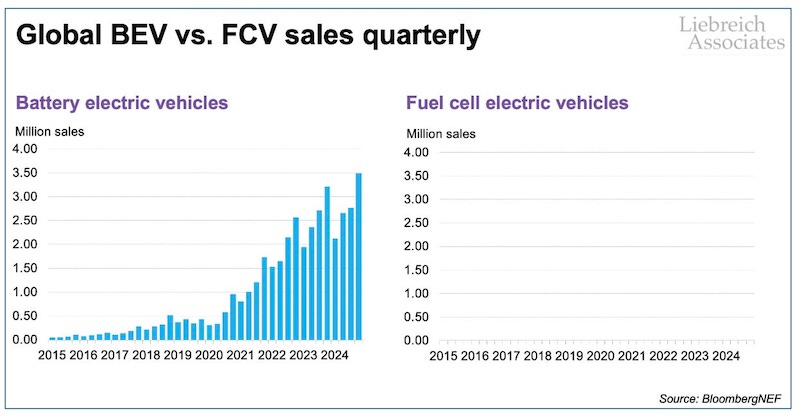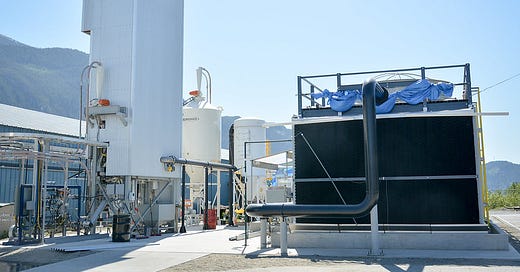Climeworks, Direct Air Capture, and the Brutal Reality of Pulling Carbon from the Sky
The poor performance of the Climeworks direct air capture plant in Iceland should be a turning point. Not just for one company, but for an entire class of false solutions.
We’re passing the mic this week to climate tech specialist and author Michael Barnard. This post originally appeared on CleanTechnica. Republished with the author’s permission.
In 2024, Climeworks’ direct air capture (DAC) Mammoth plant in Iceland captured just 105 tonnes of carbon dioxide. That’s not per day, not per week, that’s total, across the year.
For context, that’s less than the annual tailpipe emissions from a dozen long-haul trucks, or roughly one-thousandth of what the company said the plant was built to remove.
In mid-2025, the company began laying off a minimum of 10% of its ~500 staff. For a firm that raised over $800 million in equity and subsidies, hailed as a pioneer of direct air capture, the numbers are sobering. But they are not surprising. They are merely the inevitable result of colliding hopeful techno-optimism with the brutal constraints of physics, economics, and scale.
DAC has always promised a seductive narrative: the ability to suck carbon out of the sky, store it underground, and buy ourselves a climate mulligan. It promised to clean up after fossil fuels without requiring too many lifestyle changes. It was a technology that said yes—to oil companies, to airlines, to governments slow-walking their emissions policies.
And for a time, it looked like it might work. Big names like Microsoft, Stripe, and Shopify lined up to buy carbon removal credits at $600 a ton or more. Government agencies began pouring in cash. The 45Q tax credit in the United Staes was sweetened to $180 per ton. Europe and Japan set aside funds. And dozens of startups bloomed.
But beneath the marketing sheen, the physics was never on DAC’s side.
Removing CO2 from ambient air is a thermodynamic slog. The concentration is a measly 0.04%—less than one molecule in 2,500. Capturing it means moving vast volumes of air across chemically active surfaces, then applying heat, vacuum, or electric fields to regenerate the sorbents. The most mature systems, like Climeworks’ solid sorbent modules or Carbon Engineering’s hydroxide-calcination loop, require on the order of 2,000 to 3,000 kilowatt-hours of energy per ton of CO2. Even newer concepts that promise electrochemical capture still hover around 700 to 1,000 kWh per ton. And that’s just to capture it. Compressing, transporting, and injecting it underground adds another layer of complexity and cost.
Too Much Theory, Generous Subsidies
Back in 2019, I analyzed Carbon Engineering’s system in detail and concluded that it wasn’t ready for prime time. The energy requirements were steep, the system architecture was complex, and the economic case relied heavily on theoretical scale and generous subsidies.
Fast forward to today, and those conclusions still hold. Carbon Engineering’s pilot project in Squamish, British Columbia captured a few hundred tons over several years. Its first commercial plant, Stratos in Texas, is still under construction. Occidental Petroleum acquired the company in 2023. not because it had a viable climate solution, but because it had a narrative that could buy time for oil and gas.
Stratos will run on natural gas. The captured CO2 will be injected underground and earn 45Q credits, while Occidental continues to sell hydrocarbons. This isn’t carbon removal. It’s corporate theatre wrapped in a green ribbon.
Both Climeworks and Carbon Engineering rely on energy-intensive processes that significantly affect their net CO2 removal performance. Climeworks uses solid amine sorbents that require low-grade heat, typically around 80–100 °C, to regenerate. While its Icelandic operations claim to run on geothermal heat and renewables, life cycle analyses show that even with clean power, the system still re-emits about 10% of the CO2 it captures due to embedded emissions in materials, equipment fabrication, and operational energy overhead. When fossil-derived heat or grid power is used, the carbon intensity increases sharply.
Carbon Engineering’s system is even more demanding, using around 8.8 GJ of thermal energy and over 360 kWh of electricity per ton of CO2 removed. In its commercial configuration, it, too, burns natural gas to provide high-temperature heat for calcination, capturing the resulting CO2 from combustion alongside that from the air. While this design recovers some of the emissions, the system still emits roughly 0.1–0.2 tons of CO2 for every ton it captures—less if powered by renewables, more if grid electricity or inefficient fuel use is involved.
In both cases, without access to extremely low-carbon energy, the DAC process risks becoming a net emitter or offering only marginal removal at best. That low-carbon energy is much better used to power electric cars or heat pumps to avoid more CO2 being emitted in the first place, rather than used to extract homeopathic amounts of CO2 from the air.
DAC is as ‘Justification Tool’
Direct air capture, like the broader class of carbon capture and storage (CCS) projects, has been used less as a climate mitigation tool and more as a justification tool. Capture projects at the smokestack were supposed to save coal. They didn’t. DAC was supposed to save aviation. It isn’t. Now it’s being positioned as the backstop for net-zero oil and gas production, a way to square the carbon ledger while the meter keeps running.
The problem is that the math never adds up. To remove even one gigaton of CO2 annually—the lower end of what IPCC pathways suggest we might need by mid-century—we would need thousands of DAC plants the size of the one Climeworks can’t get to work. They would consume hundreds of terawatt-hours of energy annually, roughly equivalent to doubling the electricity use of a mid-sized industrial nation.
Meanwhile, global CO2 emissions are still hovering around 40 billion tons per year. DAC, across all companies, all technologies, and all years combined, has removed less than 20,000 tons to date. That’s 0.00005% of annual global emissions. It is, for all intents and purposes, noise. And it’s not getting better fast enough to matter. Mammoth’s 105 tons aren’t just a small number—they’re a warning. The technology isn’t scaling. It isn’t stabilizing. And it isn’t getting cheaper at the pace its proponents claim. The laws of thermodynamics are not falling into line. They’re enforcing a cost floor.
The economics are even more dismal. Climeworks’ removal credits have sold for between $600 and $1,000 per ton. Carbon Engineering’s contracts are rumoured to be in the $400 range. Heirloom, another promising startup using carbonate looping, hasn’t released cost data, but is operating at similarly high levels. All are subsidized. Without the 45Q credit, few if any would be viable. As a reminder, the fossil fuel and tax cuts for billionaires Republican House bill working its way through Congress cuts federal tax incentives for a raft of technologies, but leaves 45Q for carbon capture alone.
‘Climate Budgeting with Monopoly Money’
And yet, policy continues to encourage this fantasy. Climate plans, particularly from U.S. oil and gas states, are now riddled with assumptions about large-scale engineered removals beginning in the 2030s. It’s climate budgeting with monopoly money. It postpones the hard choices. It allows emissions to continue today in exchange for a speculative cleanup later.
Even when DAC does remove carbon, permanence is no guarantee. Some companies are experimenting with CO2 utilization—turning it into synthetic fuels or chemicals. That’s fine if your goal is to recycle carbon. But it’s not removal. It’s delay. Others are pairing DAC with enhanced oil recovery, which is neither climate-aligned nor economically transparent. Only a handful of firms, like Charm Industrial with its bio-oil injection strategy, are actually delivering meaningful volumes of removed and stored carbon. And even Charm is still in the thousands of tons per year—not remotely near what’s needed at scale.
So where does that leave DAC? At best, a very niche technology with specific use cases: legacy cleanup in overshoot scenarios after 2050, support for incredibly-expensive-to-decarbonize sectors—and all hard to abate sectors are finding solutions that don’t involve DAC—or localized systems where waste heat and storage capacity are incidentally co-located and there’s no other use for the waste heat, such as district heating.
But as a pillar of global decarbonization strategy, it is a fantasy. It’s climate alchemy: an expensive, energy-intensive attempt to undo what never needed to be done in the first place. Every ton of carbon avoided today is worth exponentially more than one captured tomorrow. And yet policy, funding, and media narratives continue to bet on the latter.
We’ve been here before. Carbon capture was supposed to save coal. It didn’t. DAC is supposed to save oil. It won’t. What will save us is electrification, efficiency, and prevention. Solar panels that avoid combustion. Heat pumps that sidestep fossil furnaces. Electric vehicles that displace tailpipe emissions entirely. Every watt of clean electricity deployed today reduces the need for exotic techno-fixes tomorrow. Every avoided ton of CO2 is one we don’t have to chase through the sky with a billion-dollar machine and a bag of subsidies.
Climeworks’ 105-ton year should be a turning point. Not just for one company, but for an entire class of false solutions. If DAC ever works at scale, it will be as a backup—not as a plan. Until then, we need to stop pretending we can suck our way out of this problem. We need to stop lighting carbon on fire. Because that’s the only removal that truly works.
Chart of the Week

Pipelines? CCS? Clean Energy? All of the Above? Carney Statements Fuel Anxiety, Optimism
95-Metre ‘Mega-Banner’ Urges Carney to Pick a Path, Choose Renewables and Climate Action
Lion Electric Finds New Investors, Li-Cycle Heads Toward Bankruptcy Protection
B.C.’s LNG Drive Weakens Climate Rules, Pushes Up Local Gas Prices, New Report Warns
Canada Pension Plan Abandons Net-Zero Commitment
Carney-Champagne Finance Team Brings Climate Credentials—But Must Deliver
Shell LNG Plans Receive ‘Bloody Nose’ at AGM as Social Licence Begins to Wear Thin
DOGE Guts AmeriCorps, Undermines Disaster Relief Across U.S.
Limited Grid Capacity Blocks 1,700 GW of Renewables in EU, 2,600 GW in U.S.
Nuclear has highest investment risk; solar shows lowest, say US researchers (PV Magazine)
The global EV boom is increasingly curbing oil demand (Progress Playbook)
UK Energy minister pledges to put solar panels on ‘every possible rooftop’ (The Independent)
Revealed: European ‘green’ investments hold billions in fossil fuel majors (The Guardian)
Alberta regulator orders oilsands operator to abandon its assets (Canadian Broadcasting Corporation)
Amazon fires drive unprecedented global forest loss in 2024 (Reuters)
Dire sea level rise likely even in a 1.5°C world: study (Agence France-Presse)
Over 30 Health Organisations Shun PR and Ad Agencies that Work for Fossil Fuel Industry (Global Climate & Health Alliance)
Global clean energy goals at risk as China tightens grip on key minerals, IEA warns (The Independent)
Backup plan for N.W.T. barge season under way, says gov't (Canadian Broadcasting Corporation)
Texas swelters as record-breaking heatwave sweeps across state (The Guardian)
In Chicago, Artists Imagine a World Without Prisons or Environmental Hazards (Inside Climate News)






Mostly hype without any comparison with a carbon tax.
Take the suggested cost of about $1,000 kwh per ton; combine that with the price of electricity, say $0.1 per kwh and you get $100 per ton of carbon, an amount comparable to a carbon tax.
The details are important here, but in many cases it may be cheaper to do DAC than pay a carbon tax. Airlines are a good example.